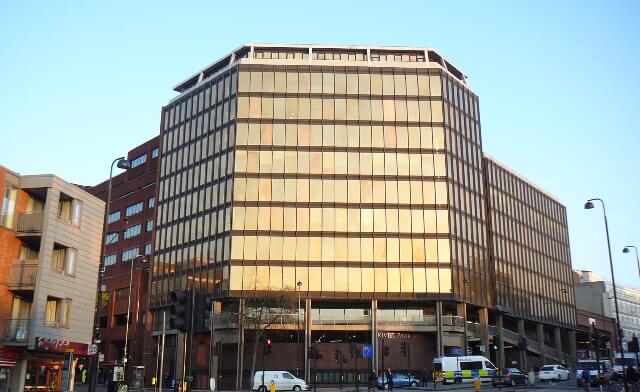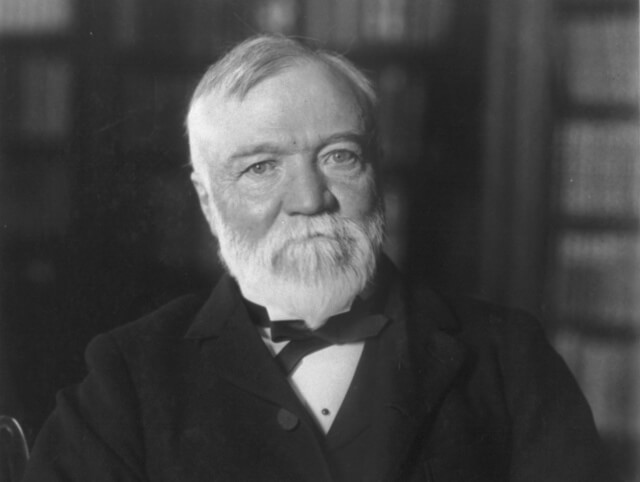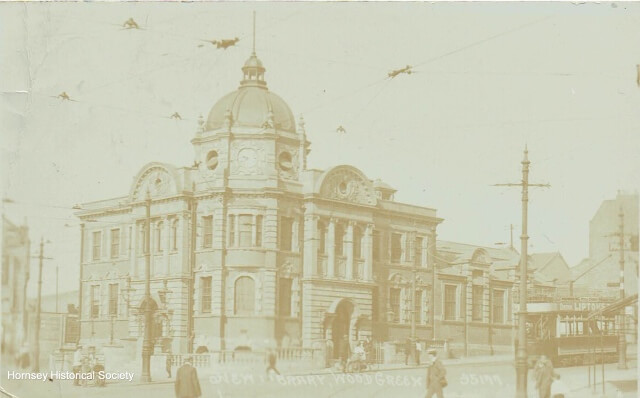
River Park House, a tall modern office block, has been home to Haringey Council since 2005. It stands on the corner of the Jolly Butcher’s Hill section of Wood Green High Road and Station Road, opposite Wood Green tube station. What stood on this prime position before it?
This is the space that accommodated Wood Green Library for 66 years. The new Library opened there to great fanfare in September 1907, the culmination of effort and momentum that had started in the second half of the nineteenth century.
An early attempt to establish a lending library in Wood Green involved the setting up of a reading room in Alexandra Palace in 1875. However, it was a small lending library in St Michael’s Church on Bounds Green Road that more firmly formed the beginnings of the public library.
The Public Libraries Act was adopted in Wood Green in 1891 after the poll to adopt the Act, required by law, had resulted in a majority of 404 in favour. A 1/2d in the pound was levied, enough to fund a part-time librarian. The library was so successful that at one point the entire stock of 602 books was out on loan.
The decision was taken to move the library into Earlham Grove House when it was purchased by the Wood Green Local Board in the early 1890s. When this became an Urban District Council in 1894, the house also became the Town Hall.
In another indication of the library’s ongoing success, a branch reading room was opened at 13 Dovecote Terrace in 1895. This not only proved popular with the reading public but was also invaluable in terms of raising funds as a coin-operated toilet was included on the premises.
By 1901 the stock had risen to 7,200 books and a printed catalogue had been produced. The library was outgrowing its home again and the Council started to look for an alternative location.
The favoured spot was the site at the corner of Jolly Butchers Hill and Station Road. This patch of land appears vacant in the OS maps of 1864 and 1894 and was part of the common and waste lands of Wood Green. The space had been considered by some as a possible site for a town hall some years before and in order to build the library, the Council paid £3050 to purchase the Lord of the Manor’s rights. The purchase having been completed, it was now a matter of negotiations with Andrew Carnegie who had offered to contribute £8,000 (roughly £979,000 today) to the construction of the new building.
Andrew Carnegie (1835-1919) was a Scottish-American steel magnate, a major philanthropist who concentrated his charitable donations on education and famously, the funding of libraries.

“A library outranks any other one thing a community can do to benefit its people. It is a never failing spring in the desert.”
Andrew Carnegie
Carnegie attached three conditions to his donations, seemingly in the hopes of securing the future of each library and of establishing their legitimacy. The first of these was the adoption of the Public Libraries Act, demonstrating a local consensus that a library was needed. The second was that the libraries had to be built on freehold land owned by the Council. These had both already been fulfilled in Wood Green but the last condition, that there could be no living accommodation in the building, was more problematic. When the plans were submitted in 1905, there was some disagreement but ultimately the Council had to concede and the building plans were altered to ensure the funding.

The library opened in September 1907. Apart from a period when the building was used as the Central Recruiting Office for the area during the First World War, it was in operation until 1973. Shortly after the building’s closure that year it was demolished. Further research, when possible, should shed light on why the building was no longer required.
The library was moved to a single storey building on the corner of Brabant Avenue and Station Road. It remained there until the opening of the current Wood Green Central Library on the High Road in 1979.
Meanwhile, the vacated plot was used to build the modern 11 storey block that stands today. River Park House, originally Sunley House, is the tallest building in Wood Green and has, for the past 15 years, been home to the main offices of Haringey Council.
Image Credits
River Park House, 2019 – Janet Owen; Andrew Carnegie 1905 – Wikimedia Commons/F B Johnston; Wood Green Library 1907 – HHS.
Sources
- Roy Hidson A Library for Wood Green
- Albert Pinching, Wood Green Past, Historical Publications 2000
- Deborah Hedgecock/Bruce Castle Museum – Memories on a Monday, Building Memories, 4 May 2020
- Bowes Park Weekly News, 5 October 1907